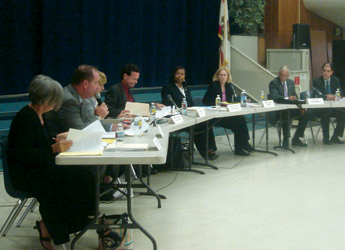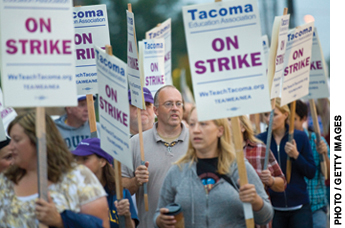
American teachers unions are increasingly the target of measures, authored by friends and foes alike, intended to limit their power, or even eviscerate them. Looking at this scene, one would never guess that the countries that are among the top 10 in student performance have some of the strongest teachers unions in the world. Are those unions in some way different from American teachers unions? Do unions elsewhere behave differently from American teachers unions when challenged to do what is necessary to improve student performance? To explore these questions, I compare teachers and their unions in Ontario, Canada and Finland with their U.S. counterparts.
In the United States, the modern labor union grew out of bitter strife between workers and owners in the early years of the 20th century. The Wagner Act, passed in 1935, guaranteed workers the right to organize and strike. Modern labor relations date from the 1947 Taft-Hartley Act, which modified the Wagner Act mainly by defining the rights of employers in the framework it had provided. These laws applied only to workers in the private sector.
The Wagner and Taft-Hartley Acts reflected the mass-production systems that the United States embraced more fully than any other industrial nation. In this arrangement, management figured out how the work was going to get done; workers were regarded as interchangeable; and skilled craftsmanship was minimized. The “skill” was in the machine, not the person operating it. And because the work was largely unskilled, pay was low.
The Wagner and Taft-Hartley Acts gave workers the right to organize to bargain for wages and working conditions. They also obligated the unions to defend their members against management when conflicts arose. The assumption was that the relationship between the union and management would be adversarial; the laws provided the rules under which that adversarial relationship would be conducted. Courts later ruled that the unions and management could not collaborate.
In northern Europe at that time, the mass-production system was not so widely embraced, the era of the craftsman did not abate, and work was less routinized and rule-bound than in the United States.
After World War II, management and owners in many Western European countries wanted to deny communism any opportunity to gain ground among workers, and so they gave labor a seat at the table. Thus three “social partners”—government, labor, and management—would frame social policy together, as equals. In many countries, the law also provided for work councils made up of workers elected by their peers at the firm level to adjust the national agreement to local conditions.
Indeed, in countries with labor parties in Europe today, it is not unusual for the labor party, when in power, to put a brake on wage growth in order to forestall inflation, or to resist calls for more benefits when productivity growth does not justify increased benefits.
In many European countries, by law, workers sit on the boards of directors of major firms. When that happens, workers sometimes offer to hold wages steady or even reduce them if management agrees to invest the savings in capital or in research and development. Workers understand that if the firm cannot make the investments required to be more competitive, it may resort to layoffs.
Senior European executives are often puzzled when their American counterparts talk about a desire to greatly weaken or even eliminate trade unions. The Europeans, while often eager to acquire more power vis-à-vis their unions, do not generally talk about eliminating them. They view the unions as an instrument for giving a voice to a key sector of the society. They generally believe that if labor were not provided a voice through the union, it might eventually become a direct threat to democratic capitalism.
The Case of American Teachers
 Prior to the 1960s, the National Education Association (NEA) was an alliance of educators, not a teachers union. The American Federation of Teachers (AFT), founded in 1916, had always been a union, but it was much smaller, and not particularly militant. But, during the ’60s, teachers’ compensation declined significantly relative to that of other occupations requiring a similar level of education. In the racial battles of the era, teachers were sometimes made the target of public anger in a way that was unprecedented and seemed quite threatening. As a result, the AFT became appealing to many teachers to whom it had not been before. The NEA shed those members who were not classroom teachers and traded its identity as a professional organization for a new one as a trade union.
Prior to the 1960s, the National Education Association (NEA) was an alliance of educators, not a teachers union. The American Federation of Teachers (AFT), founded in 1916, had always been a union, but it was much smaller, and not particularly militant. But, during the ’60s, teachers’ compensation declined significantly relative to that of other occupations requiring a similar level of education. In the racial battles of the era, teachers were sometimes made the target of public anger in a way that was unprecedented and seemed quite threatening. As a result, the AFT became appealing to many teachers to whom it had not been before. The NEA shed those members who were not classroom teachers and traded its identity as a professional organization for a new one as a trade union.
The newly energized teachers unions appealed to the AFL-CIO for help in getting state legislatures to pass laws that put teachers on much the same footing as those in unions representing workers in the private sector. The AFL-CIO was stronger then than it is now, and the teachers could put more feet on the ground in legislative political campaigns than any other single constituency. This was particularly true in the northern part of the country, where organized labor was strongest at the state level.
In the beginning, the lawyers that management hired were happy to negotiate contracts that closely followed common practice in the industrial sector. Some of these provisions simply made a teacher’s life a little easier, like lunchtime free of student responsibilities. But others had major consequences for the quality of teachers and for instruction. Among the most important of these provisions were those defining the hours of work, using seniority to determine who could transfer to jobs within the system as they opened up, and the order in which people would be laid off when staff size was reduced.
Many now think of these seniority-based rules as the result of collective bargaining. But such practices began in other industries in the 1920s—before there was any national legislation mandating collective bargaining—and were part and parcel of the mass-production workplace. Management wanted rules that were easy to administer, and, in a world in which all workers were treated as interchangeable, such a system worked well for managers in most industries.
In the case of the schools, management’s attorneys, like management’s attorneys everywhere, saw these demands as reasonable, because they were easy to administer and cost the district no money. But the organizational costs were substantial. Although the unions knew this, the school boards’ attorneys apparently did not. Thus, school boards and management gave away control over who could be hired in a school, who could fill leadership positions, how much time was available for professional development, and much, much more.
Few citizens were aware of the significance of the concessions that school boards made to unions over the years. Both school boards and the unions greatly feared teacher strikes, knowing that there were few things that could anger parents as much as not being able to put their children in school when they had to go off to work in the morning. While the teachers unions could seek higher compensation at the negotiating table, they quickly discovered that they would lose public support if the school board sought the authority to pay for raises by floating new bonds, for example. So the unions and the boards often settled their differences by negotiating changes in “working conditions,” thereby avoiding teacher strikes.
When times were tough, it was often easier for both management and labor to negotiate increased benefits, particularly retirement benefits, than increased cash compensation, because, again, the public focused on current costs rather than on obligations that would not have to be paid for many years. The unions typically negotiated benefits that would be most attractive to their longest-serving members. Over time, the compensation package got more and more expensive but less and less attractive to talented young people making decisions about which occupation to pursue.
Over the course of several decades, teachers unions in the United States progressively constrained management’s ability to select staff, promote staff, deploy staff, discipline staff, train staff, and let staff go when they were not doing the job. In the context of American-style labor relations, and the politics of American schooling, this was probably inevitable. The adversarial model of labor relations embodied in the national labor laws initially applied only to the private sector, but when President Kennedy, in an executive order, allowed members of the federal workforce to organize, state legislators adopted the private-sector model for public employees. Public-sector unions were told by their attorneys that their members could sue if they did not defend the teachers in court against school district management seeking to deprive them of their jobs. So the union lawyers routinely made it as difficult as possible to fire teachers, even those widely regarded as incompetent. Given the adversarial nature of the relationship, there was never any real possibility of teachers accepting joint responsibility for student performance outcomes, as was the case with unions in northern Europe, where the relationship has never been hostile. In the United States, student performance was the responsibility of management, not labor.
Today, American teachers want to be viewed as professionals, but their experience tells them they need their membership in the union and the clout that they have in the state legislature, even in states that do not allow them to organize. Without the unions, they might lose ground economically and be at the mercy of management that often does not treat them as professionals.
The Collaborative Model
 These dynamics set the stage for the current confrontation in the United States between the unions and the teachers on one side and, increasingly, school district management, legislatures, governors, and the public on the other.
These dynamics set the stage for the current confrontation in the United States between the unions and the teachers on one side and, increasingly, school district management, legislatures, governors, and the public on the other.
The unions are perceived to be standing in the way of badly needed reforms, protecting incompetent teachers, and putting up barricades to prevent the erosion of pension benefits the public can no longer afford. But as the unions come under increasing assault, teachers see themselves being blamed for system failures that should be attributed to others, including school boards, parents who are not supporting their children’s learning, and politicians who preside over a society in which an ever-greater number of students come to school unprepared to learn. It is hardly surprising that teachers and their unions are circling the wagons to salvage as much as possible of what they have gained since the 1960s.
It does not have to be this way.
Finland is famously a world leader in student performance. It also has some of the strongest unions in the world, and that includes its teachers unions. More than any other advanced industrial nation, Finland’s education strategy is to give teaching the highest status and make it the most desirable job in the country. The winning combination is top-quality recruits, first-rate training, and teachers with the kind of autonomy—read trust—typically accorded to other professionals but rarely to teachers. There are no top-down accountability systems in Finland, with their implied distrust of teachers, of the sort that dominate the discussion in the United States. It is hard to say which came first, the trust in the teachers or their quality, but they clearly go hand in hand. Finland’s teachers and their unions have not engaged in confrontational politics; the unions have been at the reform table for years as essential social partners.
In Ontario, Canada, one of the great PISA (Programme for International Student Assessment) success stories, the current provincial administration took over from one that had instituted a province-wide curriculum and matching assessments, along with a tough accountability system. But the Conservative government that put these policies in place had gone to war with the teachers and their unions, cutting funding, reducing professional development by half, and taking out television ads demonizing teachers. The result was a highly polarized environment, with teachers resorting to strikes and lockouts to defend what they could of their prerogatives, and no improvement in student performance.
The administration that took office in 2003 reversed course. Premier Dalton McGuinty took the view that he was not going to get the kind of student performance he was looking for if he did not have the trust and confidence of the teachers, and he would never gain their trust by continuing the war that the previous administration had begun. He and his top aides spent a lot of time to talking with teachers in classrooms and school lunchrooms. They brought teachers and their unions to the table for discussions of education reform strategy and won their trust by listening hard to what the teachers had to say and then providing the needed support. The reform strategy that they adopted assumed that teachers wanted to do the right thing but lacked the capacity to do it. So the McGuinty government focused on building that capacity. By trading trust for manifest distrust, the McGuinty government laid the base for the collaborative relationship with teachers and their unions that it saw as the prerequisite for improving student performance.
American Translation
 What can one reasonably conclude from this comparative description of the development of unions in the United States and northern Europe and the approaches taken to reform in Canada and Finland?
What can one reasonably conclude from this comparative description of the development of unions in the United States and northern Europe and the approaches taken to reform in Canada and Finland?
My conclusion is that the current impulse to curtail the influence of the teachers unions may return some powers to management that over the years have gravitated to the unions. But that victory is likely to come at the price of deeply alienating many teachers from the larger cause of education reform.
Teachers know that if they lose their unions during a fiscal crisis, they will have no protection at all as long as state and local officials face enormous pressure to cut teaching jobs, compensation, and benefits. A determined, widespread effort to weaken or destroy the institution teachers are counting on to protect them economically will force them into retirement or to hunker down and wait in brooding resentment for a change in the political weather.
As we have seen, this is precisely what happened when they came under a similar attack in Ontario, Canada. That is hardly a formula for successful education reform.
The alternative is the one taken by Ontario’s premier McGuinty: convince the teachers that they have the trust of government and enlist their unions in seeking to improve student performance. As the Ontario case shows, this does not mean that government has to give the unions whatever they want. McGuinty certainly did not do that: He made it clear where his bottom lines were. He insisted on a strong curriculum, competitive standards, and new assessments that matched them. And he was not about to break the bank.
But he invited the teachers and their unions to the table. He listened to them with respect. Where they told him that they needed support to improve outcomes for students, he supplied it wherever he could. The mutual trust that grew out of this relationship persuaded the teachers and unions to make concessions that they would never have willingly made under savage attack.
Reforming the Contract
Management will have to revisit the provisions of the contracts that school boards have negotiated over the years. Concessions will be necessary on unfunded retirement plans and on the use of seniority to govern many aspects of school-district operations. The more-or-less-unexamined move to apply the structures of the Wagner Act and the Taft-Hartley Act to the public sector needs to be reassessed. State labor legislation that mimics national labor law in its insistence on a confrontational stance between management and labor should be rewritten.
Getting to where these issues can be productively addressed requires first a relationship of trust between government and labor. Each side says that experience has taught them not to trust the other party, and so each states that trust depends on the other side making the first concessions. Someone has to go first.
Some will argue that the possibilities represented by the European model are simply not available in the United States. But our politics are not so different from those of Canada. The idea of American exceptionalism—the notion that the United States is so different from the rest of the world that lessons learned elsewhere do not apply here—had a certain allure when we were far ahead of our competitors. But it is very dangerous for a country that is falling further and further behind.
Marc Tucker is president of the National Center on Education and the Economy and editor of Surpassing Shanghai: An Agenda for American Education Built on the World’s Leading Systems (Harvard Education Press, November 2011).
This article appeared in the Winter 2012 issue of Education Next. Suggested citation format:
Tucker, M. (2012). A Different Role for Teachers Unions? Cooperation brings high scores in Canada and Finland. Education Next, 12(1), 16-20.


